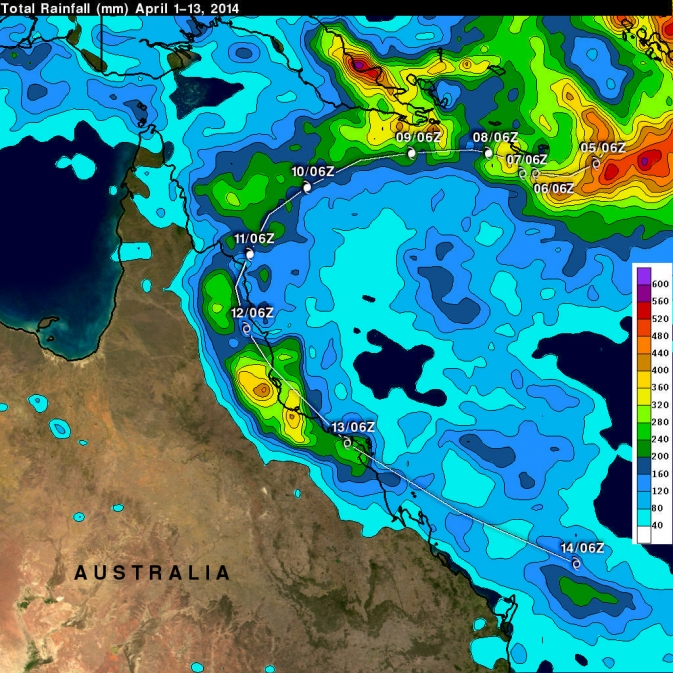NASA's TRMM Satellite Adds Up Tropical Cyclone Ita's Australian Soaking

This TRMM satellite rainfall map covers Tropical Cyclone Ita's life from April 1-14. Highest isolated rainfall was estimated around 400 mm/15.7 inches west of both Ingham and Townsville, Queensland. Ita's locations at 0600 UTC are shown overlaid in white. Image Credit: SSAI/NASA/JAXA, Hal Pierce
TRMM is a satellite managed by both NASA and JAXA, the Japan Aerospace Exploration Agency. At NASA's Goddard Space Flight Center in Greenbelt, Md. Hal Pierce created a TRMM-based near-real time Multi-satellite Precipitation Analysis (TMPA).
The TMPA precipitation data covered the period from April 1 to 14, 2014 which starts when Ita formed in the Coral Sea and moved along northeastern Australia's coast. This TRMM satellite rainfall map estimated that some of the largest isolated rainfall totals were near 400 mm/15.7 inches west of both Ingham and Townsville, Queensland.
A 3-D image of Ita was made at NASA using data collected by the TRMM satellite on April 14, 2014 at 0416 UTC/12:16 a.m. EDT after the tropical storm moved back into the Coral Sea.
TRMM's Precipitation Radar (PR) instrument found that the weakening tropical cyclone was still dropping rainfall at a maximum rate of over 161 mm/6.3 inches per hour over the Coral Sea. The 3-D image, created using TRMM PR data, showed that some storms within Ita were still reaching heights of over 13 km/8 miles as it was becoming extra-tropical.
Another NASA-shared satellite captured a visible look at Ita's remnants on April 15. The Visible Infrared Imaging Radiometer Suite (VIIRS) instrument aboard NASA-NOAA's Suomi NPP satellite captured a look at the dying extra-tropical storm. VIIRS collects visible and infrared imagery and global observations of land, atmosphere, cryosphere and oceans.
When Suomi flew over Extra-Tropical Storm Ita on April 15 at 3:53 UTC/April 14 at 11:53 p.m. EDT, VIIRS visible data revealed that Ita's structure had elongated more than the previous day. The VIIRS image showed that strong northwesterly wind shear continued to hammer the storm because the bulk of the storm's clouds were pushed southeast of the center. Ita's remnants have taken on more of a frontal appearance today as they continue to weaken at sea.
Text credit: Hal Pierce / Rob Gutro
NASA's Goddard Space Flight Center
Media Contact
More Information:
http://www.nasa.gov/content/goddard/ita-southern-pacific-ocean/All latest news from the category: Earth Sciences
Earth Sciences (also referred to as Geosciences), which deals with basic issues surrounding our planet, plays a vital role in the area of energy and raw materials supply.
Earth Sciences comprises subjects such as geology, geography, geological informatics, paleontology, mineralogy, petrography, crystallography, geophysics, geodesy, glaciology, cartography, photogrammetry, meteorology and seismology, early-warning systems, earthquake research and polar research.
Newest articles

Webb captures top of iconic horsehead nebula in unprecedented detail
NASA’s James Webb Space Telescope has captured the sharpest infrared images to date of a zoomed-in portion of one of the most distinctive objects in our skies, the Horsehead Nebula….

Cost-effective, high-capacity, and cyclable lithium-ion battery cathodes
Charge-recharge cycling of lithium-superrich iron oxide, a cost-effective and high-capacity cathode for new-generation lithium-ion batteries, can be greatly improved by doping with readily available mineral elements. The energy capacity and…

Novel genetic plant regeneration approach
…without the application of phytohormones. Researchers develop a novel plant regeneration approach by modulating the expression of genes that control plant cell differentiation. For ages now, plants have been the…





















